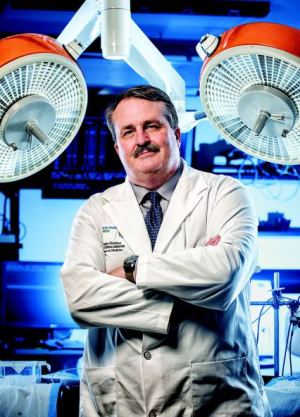 While working for NASA, Douglas Hamilton, '80 BSc(ElecEng), '84 MSc, made space safer for astronauts. Back in Canada, he's turning his attention to improving medicine in the remote regions of his home country
While working for NASA, Douglas Hamilton, '80 BSc(ElecEng), '84 MSc, made space safer for astronauts. Back in Canada, he's turning his attention to improving medicine in the remote regions of his home countryWhen Douglas Hamilton was an engineering graduate student at the U of A, he had a flash of insight that would alter his life.
Hami - as he's known around the world and in the near regions of space - has always had a fascination with how things work, so engineering was a logical career path for him. It was while he was a master's student designing surgical lasers that he began looking into human physiology. And that's when it hit him: The human body is "just one huge, incredible, complex, negative feedback and control system."
That realization would later underlie his decision to enrol in a PhD/MD program at the University of Calgary. In 1991, he graduated with his medical degree and was class valedictorian. The following year, he received his PhD in cardiovascular physiology and decided to enter the Canadian Space Agency's competition to select four new astronauts. He made it through cut after cut but ultimately came up just shy of space.
When he speaks to school groups these days, he brings along the CSA letter turning him down and a stack of other rejection letters he has received.
"I tell them that other successful people have a pile like this, too. Just because something hasn't worked out is no reason to give up."
For Hamilton, failing to make it into astronaut training led to the chance to be involved in space medicine. He attended the International Space University (where he would later teach), qualified for his United States Air Force flight surgeon wings and went to work for NASA. He supported numerous space shuttle and International Space Station missions, and his notable contributions include a redesign of the astronaut heart monitoring system. In 2012, he received NASA's Exceptional Engineering Achievement Medal for work related to the risk of electric shock for astronauts performing spacewalks.
Canadian astronaut Robert Thirsk describes Hamilton, who served as flight surgeon during Thirsk's 188-day mission in 2009, as an engineer of astonishing ingenuity. He says his friend's contributions at NASA helped secure Canada's reputation as a "top-tier space-faring nation."
Hamilton, who returned to Canada a little more than a year ago, has many memories of his time in Houston, but the most gripping has nothing to do with space. While in Texas, he helped provide medical care to Houston's indigent population. Through that involvement, he found himself serving as the lead night physician at the Astrodome in 2005 as victims of hurricane Katrina and its aftermath flooded into Houston - 30,000 people in all. For two weeks, he managed 3,000 medical personnel overseeing the care of the evacuees.
Now that he's back in Canada working as a faculty member at the University of Calgary, Hamilton is keen to use space-based technologies to fix patient-care problems in Canada. In particular, he wants to develop new telemedicine techniques for use in remote regions and to implement non-invasive technologies for monitoring brain pressure.
We at New Trail welcome your comments. Robust debate and criticism are encouraged, provided it is respectful. We reserve the right to reject comments, images or links that attack ethnicity, nationality, religion, gender or sexual orientation; that include offensive language, threats, spam; are fraudulent or defamatory; infringe on copyright or trademarks; and that just generally aren’t very nice. Discussion is monitored and violation of these guidelines will result in comments being disabled.